Classic rock is a genre that has captivated audiences for decades. It is characterized by its catchy melodies, powerful guitar riffs, and memorable lyrics. Understanding the average beats per minute (BPM) of classic rock music can provide insights into its unique sound and appeal. In this article, we will explore the characteristics of classic rock, analyze its average BPM, and discuss how tempo influences the genre. We will also look at iconic classic rock songs and their BPM, giving you a clearer picture of what defines this beloved musical style.
What is Classic Rock?
Definition and Characteristics
Classic rock refers to rock music that originated from the late 1960s to the early 1980s. It includes bands and artists that have made significant contributions to the genre. The music is known for its guitar-driven sound, strong vocals, and diverse influences. Common instruments include electric guitars, bass, drums, and keyboards. Classic rock often features prominent guitar solos and lyrical themes that resonate with listeners.
Historical Context
The classic rock era emerged in a time of cultural upheaval. The late 1960s saw the rise of counterculture movements and social change. This environment heavily influenced the music of the time. Artists like The Beatles, Led Zeppelin, and The Rolling Stones were at the forefront, blending various musical styles. This blending created a rich tapestry of sound that continues to influence musicians today.
Understanding BPM in Music
What is BPM?
BPM stands for beats per minute. It measures the tempo of a piece of music. A higher BPM indicates a faster tempo, while a lower BPM suggests a slower pace. BPM is a crucial aspect of music because it affects how a song feels and how listeners respond to it.
Importance of Tempo in Music
Tempo influences the energy of a song. Faster tempos often evoke feelings of excitement and urgency, while slower tempos can create a sense of calm or introspection. In classic rock, tempo plays a significant role in the genre’s appeal. The balance between fast and slow tempos contributes to the emotional depth of the music.
Average BPM for Classic Rock Music
General BPM Range
The average BPM for classic rock music typically ranges from 100 to 140 BPM. This range provides a foundation for many classic rock songs. However, it is important to note that not all classic rock songs fall within this range. Some songs are much faster, while others are slower.
Factors Influencing BPM
Several factors influence the BPM of classic rock songs. These include the band’s style, the song’s theme, and the intended emotional response. For example, a song about love may have a slower tempo to convey tenderness. In contrast, a song about rebellion may feature a faster tempo to evoke energy and excitement.
Analysis of Iconic Classic Rock Songs and Their BPM
The Beatles
The Beatles are one of the most influential bands in classic rock history. Their music spans a range of tempos. For example, “Twist and Shout” has a BPM of 130. This upbeat tempo contributes to its infectious energy. Conversely, “Hey Jude” has a slower BPM of 72, allowing for a more reflective mood.
Led Zeppelin
Led Zeppelin is known for its powerful sound and complex compositions. Songs like “Whole Lotta Love” have a BPM of 130, which complements its hard-hitting guitar riffs. On the other hand, “Stairway to Heaven” has a varied tempo, starting at around 60 BPM and gradually increasing, reflecting the song’s dynamic structure.
The Rolling Stones
The Rolling Stones are another pillar of classic rock. Their song “Start Me Up” features a BPM of 123, giving it a driving rhythm that invites listeners to dance. In contrast, “Angie” has a slower BPM of 85, allowing for a more introspective experience.
Queen
Queen is known for its theatrical sound and innovative compositions. “Bohemian Rhapsody” features a complex structure with varying tempos. The song starts slow at around 72 BPM before transitioning to faster sections. This dynamic range adds to the song’s dramatic flair.
Fleetwood Mac
Fleetwood Mac’s “Go Your Own Way” has a BPM of 120, blending upbeat energy with emotional lyrics. Conversely, “Landslide” has a slower BPM of 68, allowing for a reflective atmosphere. These variations showcase the band’s versatility.
BPM and Emotional Impact in Classic Rock
Fast Tempos and Energy
Songs with faster tempos often create a sense of excitement. They can motivate listeners to dance or engage actively. Classic rock songs with high BPMs tend to have strong, driving rhythms. This energy resonates with listeners and enhances the overall experience.
Slow Tempos and Introspection
In contrast, slower tempos can evoke feelings of nostalgia and introspection. Many classic rock ballads utilize slower BPMs to convey deep emotions. These songs often explore themes of love, loss, and reflection. The slower tempo allows listeners to absorb the lyrics and connect with the emotional content.
See Also: 20 Greatest Glam Rock Artists
Conclusion
In conclusion, the average BPM for classic rock music typically falls between 100 and 140 BPM. This range provides a foundation for many of the genre’s most iconic songs. Classic rock is characterized by its dynamic use of tempo, with faster songs creating excitement and slower songs encouraging reflection. Understanding the BPM of classic rock music offers insights into its enduring appeal. As the genre continues to influence musicians and listeners alike, its legacy remains strong, resonating through generations. Classic rock will always hold a special place in the hearts of music lovers worldwide.
Related Topics
Why Some Rock Music Was Nicknamed ‘Soul’?
How Corruption and Greed Led to the Downfall of Rock Music?
How Did Jazz/Rock Fusion Influence Popular Music of the 1970s?

